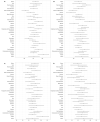Prevalence of plasma lipid abnormalities and associated risk factors among Iranian adults based on the findings from STEPs survey 2021
- PMID: 37726324
- PMCID: PMC10509214
- DOI: 10.1038/s41598-023-42341-5
Prevalence of plasma lipid abnormalities and associated risk factors among Iranian adults based on the findings from STEPs survey 2021
Abstract
The study aimed to estimate the prevalence of lipid abnormalities in Iranian adults by demographic characterization, geographical distribution, and associated risk factors using national and sub-national representative samples of the STEPs 2021 survey in Iran. In this population-based household survey, a total of 18,119 individuals aged over 25 years provided blood samples for biochemical analysis. Dyslipidemia was defined by the presence of at least one of the lipid abnormalities of hypertriglyceridemia (≥ 150 mg/dL), hypercholesterolemia (≥ 200 mg/dL), high LDL-C (≥ 130 mg/dL), and low HDL-C (< 50 mg/dL in women, < 40 mg/dL in men), or self-reported use of lipid-lowering medications. Mixed dyslipidemia was characterized as the coexistence of high LDL-C with at least one of the hypertriglyceridemia and low HDL-C. The prevalence of each lipid abnormality was determined by each population strata, and the determinants of abnormal lipid levels were identified using a multiple logistic regression model. The prevalence was 39.7% for hypertriglyceridemia, 21.2% for hypercholesterolemia, 16.4% for high LDL-C, 68.4% for low HDL-C, and 81.0% for dyslipidemia. Hypercholesterolemia and low HDL-C were more prevalent in women, and hypertriglyceridemia was more prevalent in men. The prevalence of dyslipidemia was higher in women (OR = 1.8), obese (OR = 2.8) and overweight (OR = 2.3) persons, those residents in urban areas (OR = 1.1), those with inappropriate physical activity (OR = 1.2), patients with diabetes (OR = 2.7) and hypertension (OR = 1.9), and participants with a history (OR = 1.6) or familial history of CVDs (OR = 1.2). Mixed dyslipidemia prevalence was 13.6% in women and 11.4% in men (P < 0.05). The prevalence of lipid abnormalities was highly heterogeneous among provinces, and East Azarbaijan with 85.3% (81.5-89.1) and Golestan with 68.5% (64.8-72.2) had the highest and lowest prevalence of dyslipidemia, respectively. Although the prevalence of high cholesterol and LDL-C had a descending trend in the 2016-2021 period, the prevalence of dyslipidemia remained unchanged. There are modifiable risk factors associated with dyslipidemia that can be targeted by the primary healthcare system. To modify these risk factors and promote metabolic health in the country, action plans should come to action through a multi-sectoral and collaborative approach.
© 2023. Springer Nature Limited.
Conflict of interest statement
The authors declare no competing interests.
Figures


Similar articles
-
The prevalence, awareness, and treatment of lipid abnormalities in Iranian adults: Surveillance of risk factors of noncommunicable diseases in Iran 2016.J Clin Lipidol. 2018 Nov-Dec;12(6):1471-1481.e4. doi: 10.1016/j.jacl.2018.08.001. Epub 2018 Aug 10. J Clin Lipidol. 2018. PMID: 30195823
-
Prevalence and factors associated with dyslipidemia in Bangladeshi adults.PLoS One. 2023 Jan 20;18(1):e0280672. doi: 10.1371/journal.pone.0280672. eCollection 2023. PLoS One. 2023. PMID: 36662845 Free PMC article.
-
Prevalence of dyslipidemia and associated risk factors among Turkish adults: Trabzon lipid study.Endocrine. 2008 Aug-Dec;34(1-3):36-51. doi: 10.1007/s12020-008-9100-z. Epub 2008 Nov 12. Endocrine. 2008. PMID: 19003544
-
Prevalence of dyslipidemia in iran: a systematic review and meta-analysis study.Int J Prev Med. 2014 Apr;5(4):373-93. Int J Prev Med. 2014. PMID: 24829725 Free PMC article. Review.
-
Management of dyslipidemia in the metabolic syndrome: recommendations of the Spanish HDL-Forum.Am J Cardiovasc Drugs. 2007;7(1):39-58. doi: 10.2165/00129784-200707010-00004. Am J Cardiovasc Drugs. 2007. PMID: 17355165 Review.
Cited by
-
The changes in cardiovascular disease risk factors after the implementation of the package of essential non-communicable disease control.J Cardiovasc Thorac Res. 2024;16(3):179-183. doi: 10.34172/jcvtr.33127. Epub 2024 Sep 20. J Cardiovasc Thorac Res. 2024. PMID: 39430278 Free PMC article.
-
Risk factors for non-communicable diseases in Afghanistan: insights of the nationwide population-based survey in 2018.J Health Popul Nutr. 2024 Aug 22;43(1):129. doi: 10.1186/s41043-024-00625-0. J Health Popul Nutr. 2024. PMID: 39175091 Free PMC article.
-
Prevalence of dyslipidemia and its association with blood pressure control in Iranian hypertensive patients: insights from STEPS 2021.Lipids Health Dis. 2025 Jul 7;24(1):232. doi: 10.1186/s12944-025-02660-0. Lipids Health Dis. 2025. PMID: 40624516 Free PMC article.
-
Lactobacillus paragasseri HM018 derived from breast milk ameliorates hyperlipidemia in high-cholesterol rats by modulating bile acid metabolism.Front Microbiol. 2025 Jun 4;16:1599931. doi: 10.3389/fmicb.2025.1599931. eCollection 2025. Front Microbiol. 2025. PMID: 40535017 Free PMC article.
-
Evaluation of the hypercholesterolemia care cascade and compliance with NCEP-ATP III guidelines in Iran based on the WHO STEPS survey.Lipids Health Dis. 2025 Mar 18;24(1):99. doi: 10.1186/s12944-025-02506-9. Lipids Health Dis. 2025. PMID: 40102862 Free PMC article.
References
Publication types
MeSH terms
Substances
LinkOut - more resources
Full Text Sources
Medical

